Hi Susun,
Is there an herbal approach to birth control? As far as natural birth control methods go, I’ve only heard of the rhythm method. I am curious to know if there are any herbal approaches in this area, either used alone or in conjunction with the rhythm method.
Susun’s response:
Herbal birth control is most effective when combined with knowledge of your fertility cycles, selective abstinence, mental control, and barriers to sperm. You may choose herbs to cause temporary or permanent sterility, to prevent implantation of a fertilized egg, to bring on a late menstrual flow, or to empty the uterus if you believe that conception has taken place. Although some of the herbs have potentially dangerous side effects, they are generally considered safe to use. Please respect their power.
Sterility Promoters
Stoneseed root (more info in Wise Woman Herbal for the Childbearing Year)
Jack-in-the-Pulpit root (more info in book)
Thistles (more info in book)
Implantation Preventers
Herbs which prevent the implantation of a fertilized egg do so safely and relatively painlessly by making the endometrium unsuitable for the growth of the embryo. They are taken before or after the unprotected fertilizing intercourse. Positive results are indicated by a normal menstrual flow at the normal time. Women say that when they have used these herbs their flow has been somewhat heavier and has contained more clots than usual, circumstantial evidence of a pregnancy that didn’t take. As there’s been no controlled study of possible side effects from long and regular use of these herbs, they should be used on a monthly basis. No known side effects accompany occasional use.
Wild Carrot seed (more info in book)
Rutin (more info in book)
Smartweed leaves (more info in book)
Menstrual Promoters
Herbs used to bring on or promote a menstrual flow are known as emmenagogues. There are at least fifty in common use throughout the world.
If your period is a day or two late, an emmenagogue may bring it on. If you suspect before your menstrual flow is due that you may be pregnant and wish is not to be, begin drinking a menstrual promoter a week before your expected flow.
Some Good Emmenagogues
Ginger Root (more info in book)
Tansy Leaves (more info in book)
Pennyroyal Leaves (more info in book)
Vitamin C – Ascorbic acid is the safest and reportedly most effective emmenagogue that can be used after the menstrual flow has failed to appear.
Women report success even when three weeks “late.” Six grams of vitamin C (6000 mg) is the daily dosage needed to ab*rt. Take 500 mg every hour for 12 hours a day for up to six days. CAUTION: This dosage may produce loose stools.
A List of Emmenagogues
Don’t exceed the recommended doses; many of these emmenagogues can cause strong side effects. The double dotted herbs (. .) are oxytocic; use only with focused attention and acute sensitivity to the body’s reactions. The herbs in boldface will bring on a late period about 60% of the time if the expected flow is no more than two weeks overdue.
° Angelica root: infusion, tincture (10 drops three times daily for four days)
° Fresh Lemon Balm leaves: tincture, bath
° Bethroot: infusion, tincture (a dropperful every four hours for five days)
° ° Birthwort root or whole plant in flower: infusion
° Black Cohosh root: infusion, tincture (20 drops every six hours for four days)
° ° Blue Cohosh root: infusion, tincture (20 drops every four hours for five days)
° ° Cotton root bark: infusion
° European Vervain plant: tincture (15 drops every six hours for five days)
° ° Ergot fungus: commercial extracts
° Feverfew plants in flower: tincture (40 drops every three hours for four days)
° Ginger root: infusion, tincture
° Hyssop leaves: infusion, tincture
° Liferoot plant in flower: tincture (20 drops twice daily for five days)
° Lovage root: infusion
° ° Marijuana female flowers: infusion, tincture, smoke
° ° Mistletoe leaves: infusion
° Mugwort plant: decoction
° Osha root: infusion, tincture (10 drops every four hours for five days)
° Fresh Parsley leaves: juice, vaginal insert (several sprigs, changed twice daily for three days)
° Pennyroyal plant: infusion, tincture, oil (Avoid completely before and throughout pregnancy. Oil rubbed on skin may cause miscarriage.)
° ° Peruvian bark: infusion, tincture (15 drops twice daily for four days)
° Rosemary plant in flower: infusion, tincture (20 drops twice daily for five days)
° Rue leaves: infusion, tincture (10 drops every six hours for four days)
° Saffron stigmas: one half gram daily for four days (ten grams is a fatal dose)
° Sumac berries: infusion (source of vitamin C and possibly rutin)
° Sweet Flag root: infusion, bath, tincture (10 drops every ix hours for six days)
° Tansy plant in flower: infusion, tincture
° Fresh Wood Sorrel plant: infusion, tincture (10 drops every six hours for four days)

Uterine Contractors
Herbs which promote strong uterine contractions can cause an early miscarriage or ab*rtion. Some uterine contractors are poisons, like Water Hemlock. Some herbs, such as certain seaweeds and pieces of Slippery Elm bark, are inserted into the os of the cervix to cause uterine contraction (and possible life threatening infection) by their irritating effect. Other herbs contain oxytocin, which encourages production of prostaglandins in the body; high levels of prostaglandins cause contraction of the uterus. A few herbs directly stimulate uterine contractions. If your period is no more than two weeks late, you can probably ab*rt by using a uterine contractor alone or in combination with a strong emmenagogue. Some women report success even when four weeks late. Ab*rtion is a controversial subject, and herbal ab*rtions are not an easy solution to the issues involved. Any ab*rtion is physically, emotionally, and psychically stressful. If you decide that you are not going to nourish a life growing within, please seek a woman wise in the ways of bodies and feelings to help you.
Cotton root bark Gossypium is reported to be the safest and most certain herbal abortifacient. I have tried to obtain some organic Cotton root bark for six years now, without success. My information on its effectiveness comes from a study done by a women’s health collective in New Mexico. They used an infusion taken by sips throughout the day until the ab*rtion was well under way. This is apparently a traditional method of birth control among Native Americans who grow cotton. Specific information on dosage and possible side effects should be available to women who live in the South and seek out a traditional healer or curandera.
Blue Cohosh root Caulophyllum thalictroides is usually combined with Pennyroyal when used as an abortifacient. There are any number of ways to prepare and ingest this combination. Both Pennyroyal and Blue Cohosh are toxic in excess and can easily overtax the liver and kidneys. Headache and extreme nausea have been reported by many women using these herbs. This is a common remark: “I knew that if I could just drink one more cup of that infusion, I would ab*rt, but I threw up every time I tried!” CAUTION: Do not use Blue Cohosh if you have low blood pressure.
° Emmenagogue Formulae – See Appendix II
Teratogens
Substances that cause birth defects are known as teratogens. You and the fetus are particularly sensitive to teratogens during the first five months of the childbearing year (the two months prior to conception and the first three months of pregnancy). Exposure to teratogens interferes with the rhythmic reproductive dance of your genes, chromosomes, and cells. The effects of this disruption include infertility, miscarriage, low birth weight, and a wide range of mental and physical deformities in your baby. This list of teratogens is based on Terata: A Mother’s Prenatal Health compiled by Jo Carrasco and Sue Keller. See References and Resources for reprint information.
Before and during pregnancy, completely avoid:
° Smoking
° Alcohol (including beer and wine)
° Raw or undercooked meat
° Radiation (x-rays, video display terminals)
° Caffeine (coffee, black tea, cola, chocolate, maté)
° DES (diethylstilbestrol)
° Aspirin
° Antihistamines, including Ma-huang, Ephedra, Osha root
° Most laxatives, including Flax seed, Senna, Aloes, Castor Oil, Turkey Rhubarb, Buckthorn, Cascara Sagrada
° Antacids
° Diuretics, including Buchu, Horsetail, Juniper berries
° pHisohex (or hexachlorophene)
° Hair dyes
° Hemorrhoid medications
° Chemical stimulants and depressants (LSD, psychotropics, phenobarbital, barbituates, tranquilizers)
° Motion sickness or anti-nausea drugs (Bendectin)
° Epinephrine (Adrenalin) shots
° Sulfonamides (sulfa drugs) antibiotics
° Vaccines, anesthetics, mercury vapors in dentist’s office
° Steroids and herbs containing steroid-like factors, including Agave, Ginseng, Licorice, Hops, Sage (which also decreases lactation)
° Hormones (birth control pills, most commercial meats)
° Acutane (acne medicine)
° Excesses of vitamins A, C, or D (vitamins found naturally in herbs are safer than supplemental vitamin pills)
° Heavy metals: lead, nickel, cadmium, manganese
° Pesticides, herbicides, and insecticides (particularly those containing Carbaryl)
° Fumes from paints, thinners, solvents, wood preservatives, varnishes, glues, spray adhesives, benzene, dry-cleaning fluids, certain plastics, vinyl chloride, rubber tuolene
° Lithium, arsenic
° Contact with cat feces
° PCBs (polychlorinated biphenyl)
And beware of the risks of:
° Incompatible Rh factors (possibly mitigated by one gram vitamin C with bioflavanoids taken daily during the last thirty weeks of pregnancy)
° Amniocentesis
° Electronic Fetal Monitoring, either indirect (ultrasound or direct electrode)
° Ultrasound in any form
° Prolonged exposure to extremely high temperatures
° Emmenagogues (see pages 9-10), especially during the first and last trimesters
° Common cooking herbs which may encourage miscarriage: Basil, Caraway seeds, Celery sees, Ginger, fresh Horseradish, Savory, Marjoram, Nutmeg, Rosemary, Saffron, Sage, Parsley, Tarragon, Thyme, Watercress (avoid during the first trimester; use sparingly thereafter)
° Golden Seal root (stresses liver and kidneys, raises white blood cell count, and can cause uterine contractions)
Excerpted from Wise Woman Herbal for the Childbearing Year pages 5 -14
Green blessings, Susun Weed
photos: Wise Woman Spiral © iStockphoto.com / Chuck Spidell | Sit and Breathe © Beverly Naidus


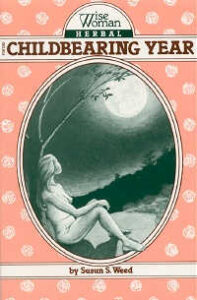
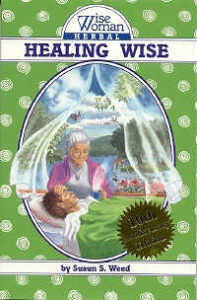
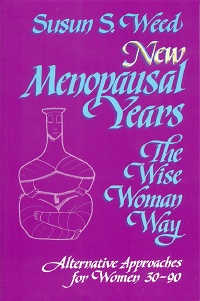
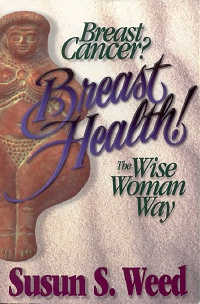
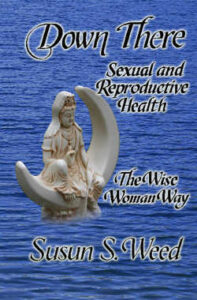
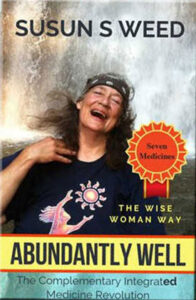


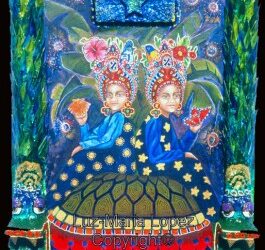
magnificent post, very informative. I ponder why the opposite experts of this sector don’t realize this.
You should continue your writing. I am confident, you have a great readers’ base already!